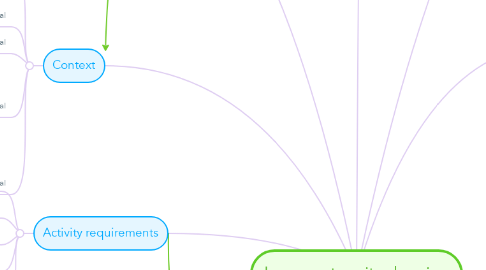
1. Diagnoses
1.1. T4 Asia A
1.1.1. Difficulties
1.1.1.1. possible respiration/endurance difficulties
1.1.1.2. upper chest, mid-back, and abdominal muscles affected
1.1.1.3. Possible autonomic dysreflexia
1.1.2. possibly to stand in standing frame
1.1.3. Hand function is usually normal
1.1.4. good strength in chest muscles
1.1.5. ability to transfer independently (bed to chair/ chair to car)
1.1.6. full head and neck movement with normal muscle strength. Normal shoulder movement
1.2. http://youtu.be/PxwI-OZEezg
2. Activity requirements
2.1. trunk stability/flexion
2.2. lateral trunk flexion
2.3. grip, lateral pinch
2.4. some internal rotation of the UE
2.5. scapular retraction
3. Context
3.1. setting
3.1.1. home- lives alone
3.1.2. School- second grade classroom
3.1.3. Inpatient rehab unit?
3.1.3.1. three hours of therapy a day plus added time
3.2. social
3.2.1. lives alone
3.3. cultural
3.4. physical
3.4.1. where does she get dressed?
3.4.2. what is the set up of her bedroom/bathroom?
3.4.3. what tools are already available in her environment?
3.5. institutional
3.5.1. insurance
3.5.2. guidelines for therapy at the hospital
4. How will we help Julie maintain balance and support herself in the different positions that are required for LE dressing
4.1. hard tech
4.1.1. using touch screen to reach forward and to the right, finding where to support herself
4.1.2. switch on far left and far right to practice balance in lateral flexion during reaching
4.1.3. A joggle switch placed with switch mount on Julie;s left side. Disengaged the mouse and used touch screen on the computer that is on her right side. Wheelchair is pulled back approx 1.5 feet and the switch mount is placed on the bar above foot rest. This is to simulate reaching for clothes and beginning to reach downward for lower extremity dressing. Julie has to find her balance to reach and hit the switch/screen to play bejewled blitz and move the jewels.
4.1.4. With switches in these positions, make sure Julie is using hook methods for balance or weight bearing and balance. ,
4.2. soft tech
4.2.1. training, have to explain to Julie how this relates to her goal of lower extremity dressing.
4.3. Future Sessions:
4.3.1. Continue playing bejeweled blitz in the computer lab and progress switches further away for continued practice with balance.
4.3.2. As she progresses, add a switch under the table to gain UE strength lifting her LE to hit the switch
4.3.3. As she progresses, she will come forward and sit at the edge of the w/c in order to be less supported and work on trunk control.
5. Human
5.1. Julie: 28 year old female, second grade school teacher. Loves bejewled blitz and has a positive attitude
5.1.1. She is an agent of change in her recovery and takes advantage of opportunities to progress
5.2. Physical
5.2.1. Skills: can use arms/shoulders/hands
5.2.2. Problematic balance
5.3. Cognitive
5.3.1. Ability: No cognitive challenges
5.4. Affective
5.4.1. Ability: Second grade teacher leads us to believe she is patient and willing to learn.
6. AT
6.1. Hard tech
6.1.1. human/technology interfaces
6.1.1.1. Positioning devices and postural support systems- needed to successfully interact with the environment
6.1.1.1.1. Standing frame
6.1.1.1.2. Wheelchair
6.1.1.2. Control Interface
6.1.1.2.1. Joystick on power wheelchair
6.1.1.3. Displays: provide information to the user
6.1.1.3.1. Display types: visual, auditory, and tactile
6.1.1.3.2. Visual Display on power wheelchair
6.1.1.4. Processor: allows for device to be tailored to individual, can also be a simple mechanical device
6.1.1.4.1. reacher: open and closes gripper to reach and carry an object
6.1.2. activity output: communication, moving from place to place, objects for self-care, work, or recreation, and performing cognitive activities
6.1.2.1. wheelchair
6.1.2.2. reacher
6.1.3. environmental interface: link between device and external worlds
6.2. Soft tech
6.2.1. performance aids
6.2.2. written instructions
6.2.3. training
7. Clinical Reasoning
7.1. Scientific
7.1.1. diagnoses, T4 asia a
7.2. Diagnostic
7.2.1. personalize client condition
7.3. Pragmatic
7.3.1. culture, cost, reimbursement
7.4. Ethical
7.4.1. staying engaged while using high tech, relying on technology alone?
7.5. Narrative
7.5.1. learn client perspective
7.6. Interactive
7.6.1. collaborate, blend goals
7.7. Procedural
7.7.1. consider occupation, task, activity constraints, use treatment processes
7.8. Conditional
7.8.1. integrate the different types of reasoning, future sessions, future after leaving Inpatient rehab.
